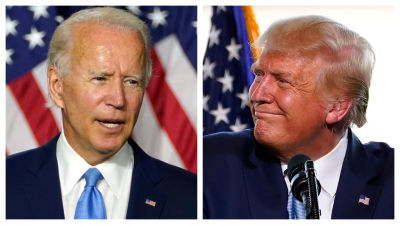2020 election Facebook attack ads: Why Donald Trump and Joe Biden are focused on one man (and it's not Donald)

Fred Dimbleby will be analysing the 2020 US election digital campaigns for our new podcast Will Trump Win?
Here he looks at how the candidates are facing off on Facebook and why they're both talking about one man...
After the furore in the aftermath of the 2016 US Election, Facebook, Google and even snapchat started 'ad libraries', which track ads posted on those sites.
They give us a real-time insight into what lines the candidates are trying to push online and allow us to open up the brain of the campaigns and see what is going on.
Will Trump Win? Listen to the latest episode below and subscribe on Apple Podcasts or Spotify
What jumps out at you immediately is just how much Donald Trump is spending on ads and how many accounts he is publishing those ads from.
There are ads published from his account, from Mike Pence's account, from the Team Trump account, from the Team Trump Store account - where you can purchase all your Trump merchandise.
In total, he advertises from 12 accounts and, just in the last 30 days, has bought over 70,000 ads costing more than $21 million. (£19 million)
In comparison Joe Biden has been advertising from just two accounts over that period publishing 11,000 ads costing $11 million (£10 million).
Biden has spent more in recent weeks but still lags far behind his opponent.
What stands out about the ads?
One person dominates both Democrat and Republican ads - Joe Biden.
Both campaigns are spending millions on defining who this veteran politician really is and what he represents.
Trump publishes ads filled with vitriolic attacks about Biden and his supporters.
One even says that Biden’s backers are "anarchists" who will "destroy our country" – doing its best to paint the base of this 77-year-old centrist Democrat as extremists.
Trump also uses the language of the ‘culture war’ – publicising incendiary debates to present his opponents as wanting to ‘take away’ rights and freedoms from his supporters.
It creates this awkward double attack of Joe Biden being ‘sleepy Joe’ while also having violent supporters wanting to radically change America.
Two people appear less often in Donald Trump’s ads.
The first is Kamala Harris.
The Trump campaign have struggled to frame their attack line on Biden’s new running mate, and it shows in the online advertising.
While there is the usual language of ‘phony’ and ‘radical’, there is little specific marketing about the presumptive Democrat vice presidential nominee.
The other person missing is Trump himself.
There are ads of his speeches and him saluting in slow motion, but there are only a small number purely focused on the President.
People know who Trump is and what he represents, so the campaign seems to be directing its efforts on painting a negative portrayal of the opposition rather than defining themselves.
The Biden campaign is attempting to do the opposite.
Trump rarely features while thousands of ads focus on the branding of ‘Team Joe’.
Despite the veteran nature of their candidate, the campaign attempts to paint the Biden/Harris ticket as an underdog, grassroots choice.
The message is that ‘Trump has more money, a big support base, and a real chance of winning’.
Biden's ads are plainer and somewhat less eye-catching than his opponent’s, but they are all about his own image.
The campaign has even spent hundreds of thousands of dollars on ads of Biden simply serving ice cream or driving classic cars.
In both campaigns, policy plays second fiddle to personality.
How have things changed since 2016?
The most significant change from the last election is that we can now see, in real time, what the campaigns are publishing online and how much they are spending.
In 2016, few knew exactly what was being spent online but now a publicly accessible tool exists to track all those ads.
Both campaigns also now realise the importance of campaigning online – something that the Clinton campaign in 2016 did not commit to fully.
Trump was ahead of the game in the last election and his campaign’s realisation of the importance of online advertising and targeting helped him on polling day.
These ads not only help the campaigns raise support, but also allow them to collect the data that is vital to a successful election run.
Both Trump and Biden post poll after poll, competition after competition, all with the aim of adding names, addresses, and contact details to their voter targeting operations.
These surveys go to extreme lengths to encourage viewers to hand over their personal information.
Some of Trump’s ads ask voters to sign a "defend the second amendment" petition while, in one of Biden’s, people are given the opportunity to add their names to a list wishing "Happy Birthday" to Barack Obama.
What lessons have been learnt?
The Democrats lost out on Facebook in 2016 and focused on more traditional forms of advertising. They are trying not to repeat that mistake.
They’re spending more and publishing many more ads online than four years ago.
The lack of a successful digital blueprint does set them back, but it also means that they can afford to take risks online.
Trump’s campaign, meanwhile, is sticking to the winning formula that put their candidate in the White House – spend and attack.
They start from a stronger base but may find it harder to innovate with a fear of diverting from the plan that was so successful last time.
One shared aspect in these campaigns is that desire to define a vision of Joe Biden.
Trump is painting him as a risk and a radical, Biden seeks to define himself as a trusted pair of hands.
The calculation for both campaigns is simple – convince more voters that their picture of Biden is most accurate.